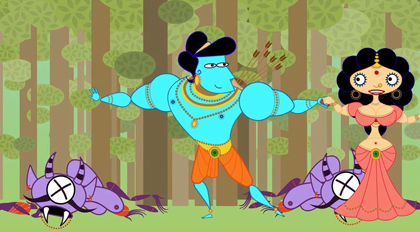Nina Paley wrote, directed, designed, produced and animated the feature-length Sita Sings the Blues, an incredible accomplishment that has been picked up by everyone from BoingBoing to Neil Gaiman. Most of the buzz around Sita Sings the Blues focuses on its legal troubles and subsequent online release under a Creative Commons share-alike license; the short version is that the titular blues recordings are out of copyright, but the songs themselves are not. Paley thought she had them cleared, but ended up taking out a loan to pay the decriminalization settlement. Releasing the work free online counts as an unlimited number of free “promotional copies,” meaning Paley doesn’t have to pay even more, and while it’s too bad the film’s release has been such a headache, this way we can all watch the festival darling from the comfort of our own computer desks. I really hope people don’t just think of Sita in the context of copyright vs. creativity; Sita is funny, poignant, and visually stunning.
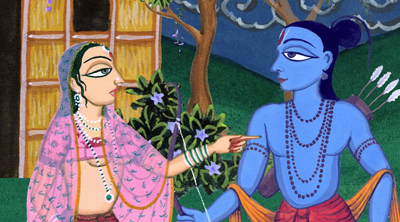
Paley provides the voice for the character Nina, an animator whose husband goes to India and breaks up with her via e-mail—true story, by the way—and both film-Nina and real Nina find food for thought in the Indian epic The Ramayana, in which the all-perfect Rama breaks up with his lovely wife Sita for what seems a flimsy excuse these days: yes, Sita spent time in the house of another man, but it was only because he kidnapped her!
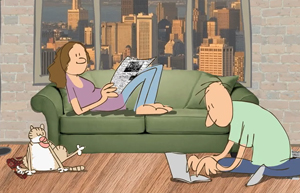 What comes across in the parallel stories is that heartache is inevitable, though not insurmountable, and Paley conveys much of the film’s emotional arc through catchy blues recordings from the ’20s. Annette Hanshaw’s crystal-clear voice pours from a curvaceous, vector-animated Sita while a cartoonish Rama and purple demons scuttle about, but that’s only one of the distinct styles in the movie: the modern-day segments are in Squigglevision with photographic elements, the non-musical parts of Sita’s story are in the familiar-looking style above (which I’ve just discovered is called Rajput brush-painting), and the narrators are Indonesian shadow-
What comes across in the parallel stories is that heartache is inevitable, though not insurmountable, and Paley conveys much of the film’s emotional arc through catchy blues recordings from the ’20s. Annette Hanshaw’s crystal-clear voice pours from a curvaceous, vector-animated Sita while a cartoonish Rama and purple demons scuttle about, but that’s only one of the distinct styles in the movie: the modern-day segments are in Squigglevision with photographic elements, the non-musical parts of Sita’s story are in the familiar-looking style above (which I’ve just discovered is called Rajput brush-painting), and the narrators are Indonesian shadow-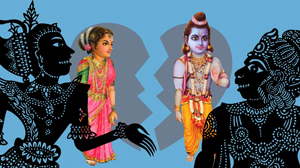 puppets. To write the narration, Paley threw three of her Indian friends in a room and asked them to talk about the Ramayana without reviewing it first. When the shadow puppets argue over details, it sounds natural and improvised because it is, and Paley includes their corrections and mistakes in the animation that goes on behind them, adding and subtracting wives or killing and unkilling the old king while they make up their minds. There’s also a set piece, after Nina’s husband ends their marriage, that features rotoscoped dancing; one of my favorite features is a series of hearts, drawn romantically, anatomically and every other way, that change in time with the sitar music.
puppets. To write the narration, Paley threw three of her Indian friends in a room and asked them to talk about the Ramayana without reviewing it first. When the shadow puppets argue over details, it sounds natural and improvised because it is, and Paley includes their corrections and mistakes in the animation that goes on behind them, adding and subtracting wives or killing and unkilling the old king while they make up their minds. There’s also a set piece, after Nina’s husband ends their marriage, that features rotoscoped dancing; one of my favorite features is a series of hearts, drawn romantically, anatomically and every other way, that change in time with the sitar music.
I can hardly believe one person did the whole thing—I mean, this is animation. It doesn’t look like Looney Tunes, but with its inventive lightheartedness and experimental storytelling, Sita Sings the Blues is the heir to classic cartooning far more than a piece of Disney drivel like Kung Fu Pa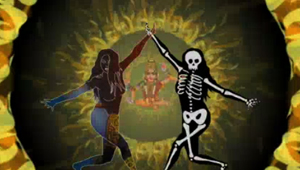 nda, and I can’t possibly convey the film’s beauty and exuberance in a few stills. The whole movie is available for download or streaming in addition to screenings being held around the world; you can contribute to Paley’s loan repayment if you like, but I don’t think you’ll have a choice about enjoying her art.
nda, and I can’t possibly convey the film’s beauty and exuberance in a few stills. The whole movie is available for download or streaming in addition to screenings being held around the world; you can contribute to Paley’s loan repayment if you like, but I don’t think you’ll have a choice about enjoying her art.










